Patrizia Lovato
Delle sue opere
hanno scritto:
Nadia Melotti
Camilla Bertoni
Philippe Daverio
Marco Bussagli
Rosella Alberti
Giuseppe Andreani
Giorgio Trevisan
Enzo Santese
Biografia
Patrizia Lovato nasce a Verona nel 1969.
Dopo il conseguimento del diploma di maturità presso l’Istituto d’Arte di Verona, si diploma in pittura all’Accademia di Belle Arti di Venezia nel 1992.
Dal 1994 svolge attività di insegnamento nelle Accademie di Belle arti di Venezia, Roma, Napoli, Bologna, Firenze, Milano. Dal 2001 al 2006 insegna anatomia artistica e tecniche espressive per la terapeutica artistica presso l’accademia di Brera a Milano.
Dal 2008 è titolare della cattedra di anatomia artistica all’Accademia di Belle Arti di Venezia.
Vive e lavora Verona.
Profile
Patrizia Lovato was born in Verona in 1969.
After receiving her secondary school diploma at the Arts Institute in Verona, she graduated from the Fine Arts Accademy in Venice in 1992.
Since 1994 teaches in the Fine Arts Academy in Venice, Rome, Naples, Bologna, Florence, Milan.
From 2001 to 2006 teaches artistic anatomy and techniques of expression for artistic therapeutic at the Academy of Brera (Milan).
Since 2008 she has been teaching Artistic anatomy at the Art Academy of Fine Arts in Venice.
Lives and works in Verona.
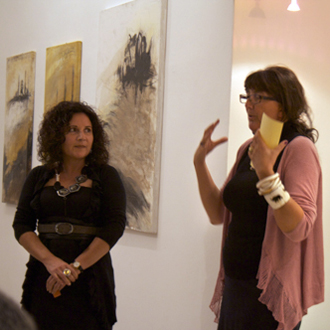
Nadia Melotti:
Il breve corso del tempo. Solitudini industriali
In un’epoca caratterizzata dal desiderio di vivere la vita in tempo reale, Patrizia Lovato ci costringe a mantenere saldo il senso del tempo come ancora di salvataggio per una coscienza poetica dell’esistenza. Il tempo inteso come una distanza tra l’esperienza e la sua rappresentazione, permette all’artista la possibilità di conoscere l’unicità della propria esperienza e sperimentarla in termini di visione. Il tempo diviene allora, assieme allo spazio, una "forma a priori della sensibilità". (…) I soggetti, i temi di studio dell’artista, sono in questo ultimo periodo legati soprattutto alle aree dismesse della società. Sono paesaggi di archeologia industriale, espressi in una tensione del gesto e del colore, quasi visti in velocità, in un’estemporanea della memoria che spinge il ricordo ad esistere nella sua brevità. (…) L’artista sceglie l’attimo del ricordo e lo elabora in una sintesi segnica capace di individuare l’architettura della visione in un’atmosfera cromatica che la rende profondamente emotiva. Sono improvvisazioni di colore, casualità di macchie che sgocciolano sottili stati d’animo. La complessità del paesaggio naturale od urbano viene purificata della forma a favore delle linee di forza, dei punti di energia che irrompono con estremo vitalismo nello spazio primigenio della creazione. (…)
Nadia Melotti:
The short course of time. Solitudes industrial
In an era characterized by the desire to live life in real time, Patrizia Lovato forces us to maintain balance the sense of time as yet to rescue a poetic consciousness of existence. Time understood as a gap between experience and its representation, allows the artist to be aware of the uniqueness of their experience and test it in terms of vision. Time then becomes, together with the space, an "a priori form of sensibility." (…)The subjects, themes studio, in this period are mainly related to the abandoned areas of society. They are landscapes of industrial archeology, expressed as a power of gesture and color, as seen in velocity, an impromptu memory that pushes the memory to exist in its brevity. They are places that bear witness that there is no longer the old industrial processes now abandoned to become virtual. The artist chooses the moment of remembrance and processes it in a synthesis of signs that can identify the architecture of vision in a color that makes deeply emotional. Improvisation are color, random spots that sgoccialono subtle moods. The complexity of the natural landscape or urban is purified form for the lines of force, the points of energy that burst with great vitality in the space of primal creation. (…)
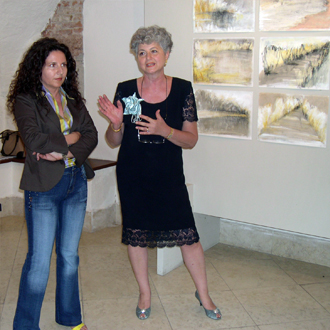
Camilla Bertoni:
Paesaggi interiori
L’artista veronese propone una nuova ricerca di opere pittoriche materiche e disegni, fondata su un immaginario che si esprime attraverso una ricerca pittorica materica e che non si dipana sulla visione diretta, ma piuttosto attraverso i filtri della memoria, della tradizione e del suo mondo interiore. I paesaggi, (…) stanno in bilico tra la realtà e l’immaginazione, (…) quasi fossero segni astratti prodotti dalla mente o dalle e mozioni, paesaggi interiori.”(…) Mentre nella sua pittura prendono corpo le sensazioni, è naturale che quelle sensazioni usino per venire a galla il linguaggio noto del mondo che attraverso gli occhi si è depositato nel cuore dell’autrice. E non solo: emerge e si riconosce nel suo fare anche una lunga tradizione artistica, tipicamente veneta, nelle luminosità, nelle velature che costituiscono un tonalismo soffuso e dorato. Non a caso Patrizia si è formata a Venezia dove ha imparato a conoscere e gestire la materia per poter riuscire a dare corpo alle sue visioni.(…) In questa serie di opere si raggiunge una particolare e peculiare qualità: alberi, acqua, riflessi e luce diventano simboli privilegiati di un mondo interiore dibattuto tra restare legato alle radici, all’origine, e tendere verso un altrove di luce. Una dicotomia nella quale Patrizia Lovato si riconosce e che oggi sembra aver trovato un equilibrio ottimale nella scelta tematica e nelle soluzioni formali. Alla fine la sovrapposizione della visione, della memoria, del sentimento e della materia pittorica avviene in modo tale da far coincidere esattamente il paesaggio esterno, consueto e famigliare, con quello della tradizione pittorica in cui Patrizia Lovato si è formata e con quella del suo mondo interiore. Una coincidenza che è il segno stesso e la chiave della sua poetica.
Arte nel Verde
(…) Compito degli artisti è quello di restituire al verde la sua essenza e la sua libertà, di minare le nostre certezze, di far saltare le nostre semplificazioni. E le parole di Maurice Merlau-Ponty, scritte nel mezzo secolo scorso, le parole che Patrizia Lovato ha scelto come suo faro guida: “chi non dipinge dal vivo, dipinge comunque perché ha visto, perché il mondo ha inciso su di lui le cifre del visibile”, sono ancora le parole di oggi. (…) E anche quegli alberi (ma sono poi alberi?) di Patrizia Lovato sembrano più appartenere ad un mondo interiore che a un paesaggio esteriore.
Camilla Bertoni:
Inner world
Veronese artist proposes a new search textured paintings and drawings based on imagery that is expressed through a search and pictorial material that does not unfold on direct vision, but rather through the filters of memory, tradition and its world interior. ... His landscapes ... are poised between reality and imagination, almost like abstract signs and products from the mind or the motions, inner landscapes. ... (...) While painting come to life in his feelings, it is natural that those feelings use the language to come to the surface of the known world through his eyes is deposited in the heart of the author. Not only that emerges and is recognized in his work is also a long artistic tradition, typically Venetian, in brightness, in glazes that are suffused with a tonality and golden. Patrizia no coincidence was formed in Venice, where he learned to know and handle the matter in order to be able to give shape to his vision (...). In this series of works to reach a particular and peculiar qualities: trees, water, reflections and light become symbols of a privileged inner world torn between staying with roots, origin, and move towards a light elsewhere. A dichotomy in which Patricia Lovato recognizes and now seems to have found an optimal balance in the formal and thematic solutions. At the end of the overlap of vision, memory, and feeling of the painting is done in order to match exactly the external landscape, the usual and familiar with the pictorial tradition in which Patricia Lovato was formed and that of his world interior. A coincidence is that the sign and the key to his poetry.
Art in the green
(...) The task of the artists instead is to return to green its essence and its freedom, undermining our certainties, to blow our simplifications. And the words of Maurice Merlau-Ponty, written in the last half century, the words Lovato Patrizia has chosen as his guiding light "who does not paint live, paint it anyway because he has seen, because the world has had on him (... ) digits of the visible, "are the words of today. (...) And those trees (but then the trees?) Patrizia Lovato who seem to belong to an inner world than an exterior landscape.
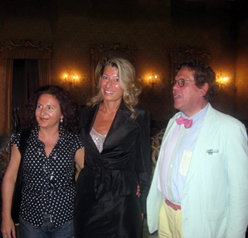
Philippe Daverio:
Palazzo Cusani Milano
Le donne son venute in eccellenza
di ciascun arte ov’hanno posto cura.
Ariosto, Orlando furioso, XX, II, 1-2
Le opere delle artiste presentate, a cui si riconosce sensibilità nel cogliere problematiche storiche, sociali, morali (…) offrono (…)una varietà interessante di coloriture d’espressione, spesso in bilico tra attardati romanticismi e qualche sguardo al linguaggio di una società in mutamento, quella del secolo nuovo. Nell’epoca del trionfo della tecnologia avanzata, dell’utilizzo di mezzi e strumenti assai complessi (…), il manufatto artistico resta ancora il documento e il linguaggio più credibile per descrivere il pensiero, la cultura, il periodo storico.(…) Ogni dipinto racconta una storia e, se lo sappiamo leggere, ci parla di un luogo, di un’epoca, di un’intera cultura con i suoi codici.(…)
Philippe Daverio:
Palazzo Cusani Milano
The works of artists are characterized by a sensitivity problems in grasping the historical, social, moral (...) offer (...) an attractive variety of colorings of expression, often in the balance between romanticism and some look at the language of a changing society, that of the new century. In the era of the triumph of technology, use of instruments and highly complex (...), the art work still remains the most credible document and the language to describe the thought, culture, historical period. (...) Each painting tells a story and if you know how to read, speaks of a place, of an era, an entire culture with its codes. (...)
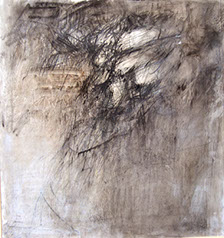
Marco Bussagli:
Pensieri sull’opera di P. Lovato
(…) Patrizia Lovato batte una terza via che si configura come l’intrecciarsi delle prime due, dove il confine fra ciò che è fuori e ciò che è dentro si fa impercettibile e i due mondi si fondono in un’unica – indissolubile – visione onirica. Sembrano , i suoi, quasi appunti di viaggio, schizzati all’improvviso mentre si passa sul ponte delle Anime. E invece, quando ci si avvicina alla superficie dell’opera ci si rende conto di come la rapidità sia solo apparente, di quanto ogni gesto che lascia traccia nella tempera, nell’olio, nella grafite o nel bitume sia pensato e studiato. Ma non secondo un libresco apprendimento: è un segno che scaturisce dalla meditazione interiore, dalla riflessione su se stessi. Allora, i fili d’erba dei prati divengono scure masse di segni che si intrecciano e si aggrovigliano come nodi dell’anima, gli alberi tendono i rami verso l’alto per abbracciare i sogni e tutta la superficie pittorica si anima come quando si getta un sasso nell’acqua immota di uno stagno. È quella delle opere di Patrizia una luce tremula e incerta, quasi avvolta dalla nebbia di una precaria esistenza, ma che talora è capace di scoppi improvvisi e abbacinanti, di bagliori sorprendenti che assomigliano alle offerte di gioia che ci dona la vita.
Marco Bussagli:
Thoughts on the work of P. Lovato
(…) Patrizia Lovato beats a third way that is configured as the interweaving of the first two, where the border between what is outside and what is inside you imperceptible and the two worlds merge into one - an indissoluble - dream vision. Seem, its almost travel notes, sketches and suddenly goes on the deck of Souls. But when you approach the surface of the work we realize how the speed is only apparent, because every act of leaving a trace in tempera, oil in graphite or bitumen is designed and studied. But not in a bookish learning is a sign that springs from inner meditation, reflection on themselves. Then the grass of the meadows become dark masses of signs that are intertwined and tangled knots of the soul as the trees the branches tend upwards to embrace the dreams and all the paint surface becomes animated as when he throws a motionless stone into a pond. And ‘that works Patrizia a flickering and uncertain, almost enveloped by the fog of a precarious existence, but sometimes that is capable of dazzling bursts and sudden, surprising flashes of offerings that look of joy that gives us life.
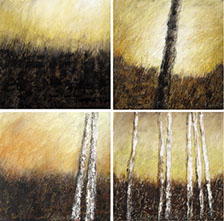
Rosella Alberti:
Gli alberi di Patrizia Lovato
(…) Estranea all’oggettività analitica che riconduce l’esperienza creativa alla cosa e alla sua figurazione rappresentativa, lontana dai meccanismi della dilagante iconosfera multimediale e fedele alle regole della pittura e della sua storia, Patrizia Lovato rinviene i motivi del dipingere nel contatto con la realtà circostante e fisica dei suoi “luoghi padani”; e tuttavia non guarda solo la natura, vi si trova immersa; non la fotografa distanziandosi da essa, piuttosto inventa prima il quadro e successivamente rielabora la natura che vi prende forma per renderle nuova consistenza e diversa essenzialità, anche in termini romantici ed esistenziali. Non è un caso l’amore di Patrizia per Goethe e per Klee (entrambi, in tempi e per motivi diversi, cantori della Natura) (…) La luce diventa materia pittorica che origina, segno dopo segno, dalla mano dell’artista. (…) È un linguaggio poetico giocato sul contrasto, sull’antitesi delle grandi campiture di bianchi e di scuri, che non rinunzia ad effetti di spazialità nei quali alligna la scansione temporale delle emozioni pittoriche. (…) E come il vissuto si mostra nel trasporsi ambiguo delle immagini e delle emozioni, altrettanto cariche di ambiguità appaiono le regole della composizione tradizionale del paesaggio nel dipingere dalla Lovato: sopra la struttura del disegno che guida l’ordito di ogni opera, si innesta aggressiva la stesura del colore dalla quale prendono corpo le forme della natura e degli alberi, solo suggestioni luminose rese attraverso scanalature prospettiche di natura cromatica che invitano noi osservatori a farci interpreti e traduttori dei sentimenti e delle sensazioni che le hanno generate. Ma non come testi di lettura, piuttosto come ascolto di brani musicali, dove - e questo Patrizia ben lo sa - l’ascolto è già un modo di interpretare e reinventare l’opera, in questo caso un adagio malinconico proprio della terra veronese.
Rosella Alberti:
Patrizia Lovato’s trees
...) Alien analytical objectivity that leads the creative experience to the thing and its representative figure, far from the mechanisms of invasive iconosfera multimedia and true to the rules of painting and its history, Patrizia Lovato recovers the reasons for the paint in contact with the reality of his physical surroundings and “places Po,” and does not look only nature, there is immersed, not the photographer reach, rather than inventing the first part and then to transform the nature that is shaped so as to bring new consistency and other essentials, including their romantic and existential. Love is not a case of Patrizia Goethe and Klee (both in time and for different reasons, singers of Nature)(...)The light becomes pictorial material that generates, sign after sign, from the hand of the artist.(...) It ‘a poetic language played on the contrast, sull’antitesi large backgrounds of white and dark, not to renounce the effects of space where emotions thrive scan time of painting. (...) And as the experience shows in trasporsi ambiguous images and emotions, so full of ambiguity are the rules of traditional composition of the landscape in painting from Lovato: on the structure of the design that drives the plot of each work, joins the aggressive application of color body which take the forms of nature and trees, only suggestions made by bright color channels perspective of nature that invite us to make us observers interpreters and translators of feelings and sensations that are generated. But not as a test of reading, rather like listening to music, where - and this Patrizia well knows - listening is one way of interpreting and reinventing the work, in this case a slow melancholy of its land in Verona.
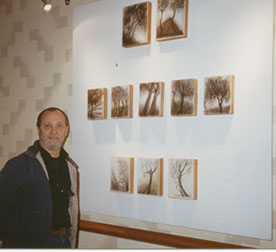
Giuseppe Andreani:
Verso il declino della luce
Mentre indugiavo davanti a queste opere che Patrizia Lovato mi presentava, nel suo studio veronese, ad una ad una, con grande dovizia di particolari, soffermandosi sui motivi ispiratori della sua creatività, sul perché, quando, dove e come ogni lavoro aveva preso forma, la mia mente veniva attratta dall’inflessione della voce dell’artista, che con scientifica insistenza introduceva ogni opera con le medesime parole: “nasce dalla mia ossessione per la natura intesa come alberi, cortecce, foglie, terra, varietà e metamorfosi di forme…”(...) Osservando i lavori di Patrizia, mi pareva cioè di individuare in alcuni temi ispiratori della cultura astratto-informale - tra cui proprio il motivo ossessivo della natura - il costituirsi dell’orizzonte critico su cui si era formata l’artista (penso all’Accademia di Belle Arti di Venezia e alla presenza di un Emilio Vedova), per la quale l’ossessione della natura coincideva forse con un movimento di risalita verso l’origine: natura come sentirsi dentro la vita, come quel sentimento biologico della vita, profondo, precoscienziale, come quell’interlocutore genetico che faceva da sottofondo inconscio all’interrogativo primo dell’umano esistere: “da dove vengo, chi sono e dove vado”.(…) E l’Adige era un luogo che Patrizia ricercava quasi istintivamente, e che frequentava spesso, prima ancora che il fiume fosse arrivato in città, per quelle carrarecce solitarie che attraversavano la vegetazione lungo gli argini, nei soffocanti vapori dell’estate e nelle nebbie invernali, quando gli alberi scarniti si ergevano repentinamente davanti come forme spettrali; di mattina, al risveglio della natura fluviale, e di sera quando il trascolorare della luce, falsificando la percezione della realtà, inventava forme nuove e inusitate. Nello studio, tutte queste emozioni e sensazioni e vibrazioni, questo sentimento inquieto e traboccante della natura si traducevano in materia della pittura e del disegno, ma senza tornare oggetti o figure, continuando piuttosto a sussistere come emozioni, vibrazioni, sensazioni e sentimenti evocati, raccolti, chiamati alla presenza, dei quali l’artista ricercava le forme e le loro metamorfosi, ne indagava la consistenza, ne rendeva le apparenze fantasmatiche, fino a restituire loro nuova vita.(…) Patrizia Lovato rinviene i motivi del dipingere nel contatto con la realtà circostante e fisica dei suoi “luoghi padani”; e tuttavia non guarda solo alla Natura, vi si trova immersa. Natura che si guarda, si respira, si sente, si soffre… Natura come sentirsi dentro la vita, come quel sentimento biologico della vita, profondo, precoscienziale….Queste e mozioni, sensazioni e vibrazioni, si traducono in materia della pittura e del segno, ma senza tornare oggetti o figure, continuando piuttosto a sussistere come emozioni, vibrazioni, sensazioni e sentimenti evocati, dei quali, l’artista ricerca e crea forme ed armonie sempre diverse.
Giuseppe Andreani:
Towards the decline of lights
While these works that linger in front of me Patrizia Lovato presented in his studio in Verona, one by one, with fine details, focusing on the reasons underlying his creativity, why, when, where and how each work took shape, my mind was attracted dall’inflessione voice artist, whose scientific insistence introduced each work with the same words: “born from my obsession with nature as trees, bark, leaves, soil, varieties and forms of metamorphosis (…) Observing the work of Patrizia, that seemed to identify some underlying themes of abstract-informal culture - including why his obsessive nature - constituted the critical horizon which had formed the artist (think Academy Fine Arts in Venice and the presence of a Emilio Vedova), for which the nature of obsession perhaps coincided with a movement of ascent towards the source: nature like feeling in life, like that feeling of organic life, deep, precoscienziale as quell’interlocutore genetic background was unconscious from the first to the question of human existence: “Where I come from, who I am and where I go.” (...) And the South was a place that almost instinctively sought Patrizia, which was often, even before the river had come to town, for those lonely dirt roads crossing the vegetation along the banks, the stifling fumes of summer and winter fog when the trees stripped suddenly stood before him like spectral shapes, in the morning, the awakening of nature river, and when the fading evening light, falsifying the perception of reality, inventing new and unusual forms. In the study, all these emotions and feelings and vibrations, this feeling restless and overflowing of nature is a matter of painting and drawing, but without returning objects or pictures, rather than continuing to exist as emotions, vibrations, sensations and feelings evoked, collected , called the presence of which the artist sought out the forms and their metamorphosis, they investigated the consistency, he made ghostly appearances, to surrender their new life. (…) Patrizia Lovato recovers the grounds of paint in contact with the surrounding reality and its physical “places Po,” and does not just look to nature, there is immersed. Nature that looks, breathes, feels, you feel like you have ... Nature in life, like that feeling of organic life, deep,.... These and motions, vibrations and feelings are reflected in the field of painting and sign but without returning objects or pictures, rather than continuing to exist as emotions, vibrations, sensations and feelings evoked, of which the artist creates forms and research and harmonies are always different.(…)
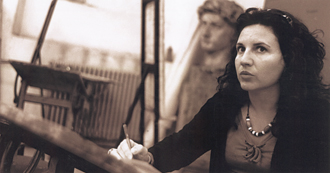
Giorgio Trevisan:
Patrizia e la Natura
(...) È la spontaneità del gesto, unita alla naturale vitalità operativa dell’artista a determinare una pagina espressiva sostenuta da una profonda conoscenza del mezzo tecnico, la quale le consente di segnare, in modo indelebile, la qualità del suo fare e la freschezza del pensiero creativo. (...)
Giorgio Trevisan:
Nature’s Patrizia
(…) It is the spontaneousness of the act, together with the natural operational vitality of the artist which determines an expressive page, supported by a profound knowledge of the technical means which allows her to mark, in an indelible way, the quality of her actions and the freshness of her creative thinking. (...)
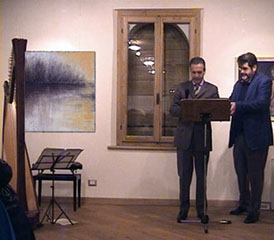
Enzo Santese:
Arte tra le mura
(…) Con Patrizia Lovato entriamo nella dimensione del paesaggio. È un paesaggio vissuto non come necessità di rappresentazione del reale, casomai come urgenza di evocare del reale quelle sensazioni che il reale stesso suggerisce. C’è sempre nei suoi quadri un indicazione di un orizzonte. Su questo orizzonte crescono come per incanto delle realtà vegetali. C’è l’idea della specularità su tratti d’acqua che impegnano l’artista a poggiare il suo intervento sull’idea di trasparenza, della velatura, insomma dell’oltre.
Enzo Santese:
Art between the walls
(…) By Patrizia Lovato we enter the dimension of the landscape. It ‘not as a living landscape of the real need for representation, as in case of real urgency to evoke the sensations that reality suggests. There is always an indication of his paintings un’orizzonte. On this horizon grow as if by magic plant of reality. There is the idea of specularity on stretches of water to engage the artist based his speech on the idea of transparency, fog, short of the beyond.
Patrizia Lovato • cell. 347 4578737 • email: patrizialovato@hotmail.it • © Tutti i diritti riservati - All rights reserved
Web design e foto: Antonio Canteri